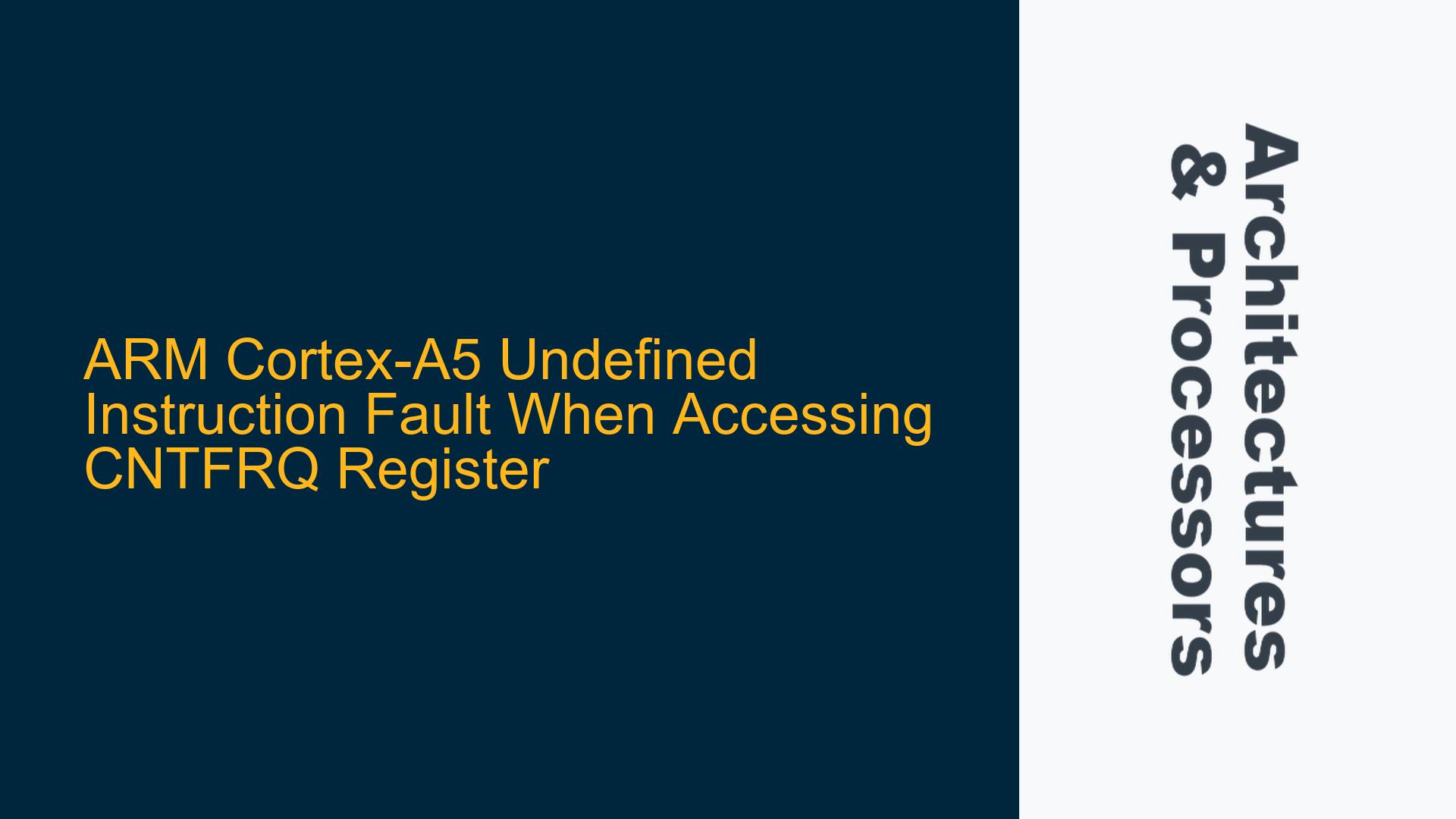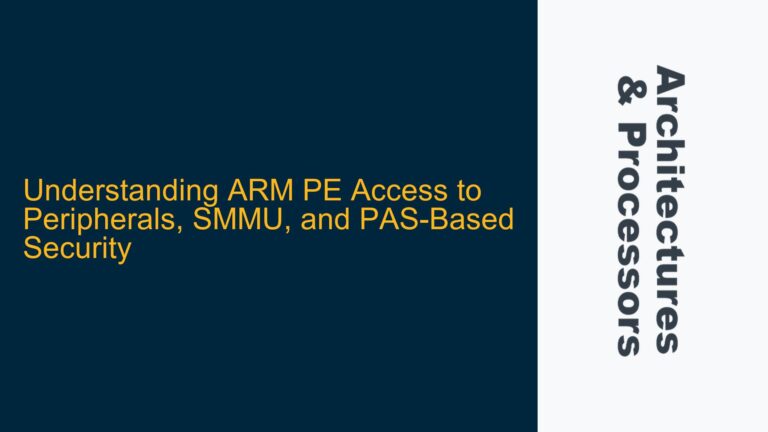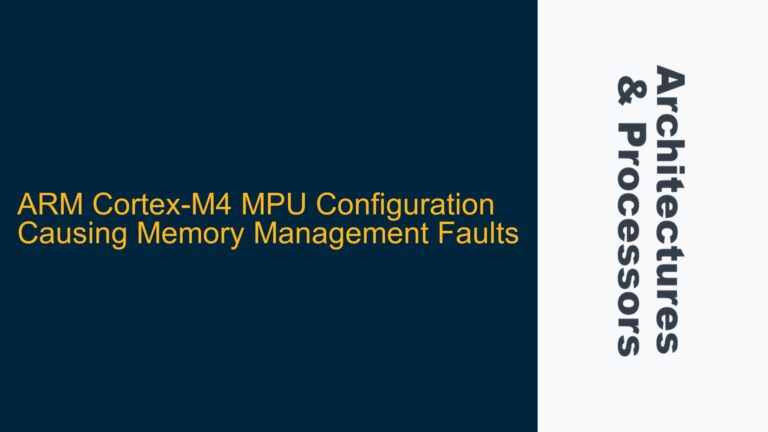ARM Cortex-A5 Generic Timer Unsupported and CNTFRQ Access Issues
The ARM Cortex-A5 processor, part of the ARMv7-A architecture, does not support the Generic Timer feature, which is a critical detail often overlooked by developers transitioning from newer ARM cores or referencing the ARM Architecture Reference Manual (ARM ARM) without considering core-specific limitations. The Generic Timer, introduced in later ARM cores such as the Cortex-A7 and Cortex-A15, provides a system counter and timer facilities accessible via coprocessor CP15 registers. Attempting to access the CNTFRQ (Counter Frequency Register) on a Cortex-A5 results in an "Undefined Instruction" fault because the Cortex-A5 lacks the hardware support for this feature. This issue is compounded by the fact that the ARM ARM describes the CNTFRQ register access method generically, without explicitly stating which cores support it.
The CNTFRQ register is part of the Generic Timer architecture, which is optional in ARMv7-A and mandatory in ARMv8-A. The Cortex-A5, being an older core, predates the introduction of the Generic Timer and instead relies on memory-mapped timers for its timing needs. When software attempts to execute the MRC (Move to Register from Coprocessor) or MCR (Move to Coprocessor from Register) instructions to access CNTFRQ, the Cortex-A5 triggers an undefined instruction exception because these opcodes are not implemented in its CP15 coprocessor interface.
To verify the presence of the Generic Timer, software should read the ID_PFR1 (Processor Feature Register 1) register, which indicates whether the Generic Timer is supported. The absence of this feature in the Cortex-A5 means developers must use alternative timing mechanisms, such as the memory-mapped timers described in the Cortex-A5 Technical Reference Manual (TRM). This issue highlights the importance of consulting core-specific documentation alongside the ARM ARM to avoid such pitfalls.
Undefined Instruction Fault Due to Unsupported CP15 Opcodes
The root cause of the undefined instruction fault lies in the Cortex-A5’s lack of support for the specific CP15 opcodes used to access the CNTFRQ register. The MRC and MCR instructions are used to move data between ARM registers and coprocessor registers. In the case of CNTFRQ, the opcode configuration <opc1>=0, <CRn>=c14, <CRm>=c0, <opc2>=0 is not recognized by the Cortex-A5’s CP15 implementation. This results in the processor treating the instruction as undefined, triggering an exception.
The ARM architecture allows for significant variation in coprocessor implementations across different cores. While the ARM ARM provides a unified description of coprocessor registers and their access methods, it does not guarantee that all cores support every feature. The Cortex-A5, being an earlier implementation of the ARMv7-A architecture, omits certain features to optimize for cost and power efficiency. This includes the Generic Timer and its associated registers, such as CNTFRQ.
Developers must be aware of these variations and verify feature support before attempting to use advanced architectural features. In the case of the Cortex-A5, the absence of the Generic Timer means that the CNTFRQ register is not accessible, and attempting to access it will always result in an undefined instruction fault. This behavior is consistent with the ARM architecture’s design, where unsupported opcodes are treated as undefined to maintain compatibility across cores with different feature sets.
Implementing Memory-Mapped Timers and Verifying Feature Support
To resolve the undefined instruction fault and achieve the desired timing functionality on the Cortex-A5, developers must use the memory-mapped timers provided by the core. These timers are documented in the Cortex-A5 TRM and offer similar functionality to the Generic Timer, albeit with a different programming interface. The memory-mapped timers are accessed via the processor’s memory bus, eliminating the need for coprocessor instructions.
Before implementing any timing solution, software should verify the presence of the Generic Timer by reading the ID_PFR1 register. This register contains bit fields that indicate whether the Generic Timer is supported. On the Cortex-A5, these bits will be clear, confirming the absence of the Generic Timer. The following code demonstrates how to read the ID_PFR1 register:
uint32_t read_id_pfr1(void) {
uint32_t pfr1;
asm volatile("mrc p15, 0, %0, c0, c1, 1" : "=r"(pfr1));
return pfr1;
}
If the Generic Timer is not supported, developers should consult the Cortex-A5 TRM to identify the memory-mapped timers and their programming interface. These timers typically include a counter register, a control register, and an interrupt enable/disable mechanism. The following example demonstrates how to initialize and use a memory-mapped timer:
#define TIMER_BASE 0xFFFF0000 // Base address of the memory-mapped timer
#define TIMER_CTRL (TIMER_BASE + 0x00) // Control register offset
#define TIMER_COUNT (TIMER_BASE + 0x04) // Counter register offset
void timer_init(void) {
// Enable the timer and set its frequency
*(volatile uint32_t *)TIMER_CTRL = 0x1;
}
uint32_t timer_read(void) {
// Read the current counter value
return *(volatile uint32_t *)TIMER_COUNT;
}
By using memory-mapped timers, developers can achieve precise timing on the Cortex-A5 without encountering undefined instruction faults. This approach ensures compatibility with the core’s feature set and avoids reliance on unsupported coprocessor instructions.
In conclusion, the undefined instruction fault when accessing the CNTFRQ register on the ARM Cortex-A5 is caused by the core’s lack of support for the Generic Timer. Developers must verify feature support using the ID_PFR1 register and use memory-mapped timers as an alternative. This issue underscores the importance of consulting core-specific documentation and understanding the variations in ARM architecture implementations. By following these guidelines, developers can avoid common pitfalls and ensure reliable system implementations on the Cortex-A5 and other ARM cores.






